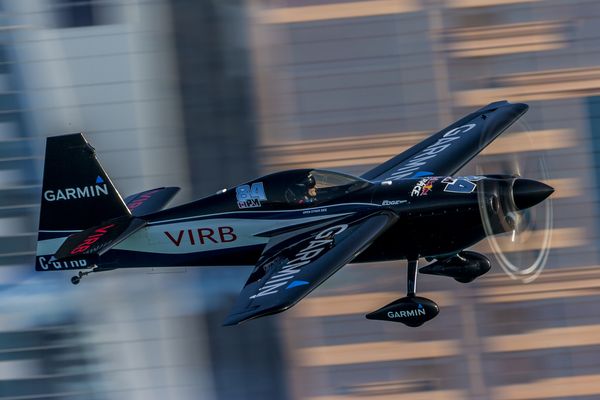The Pete McLeod Zivko Edge 540
This weekend, Team Garmin pilot Pete McLeod makes his way to Dallas-Fort Worth for the second to last stop on the 2015 Red Bull Air Race World Championship tour. With a third place finish at last year’s Texas event, McLeod looks to continue his run of success on American race courses. We had a chance to talk with Pete and team coordinator Dan Gysbers, to learn more about the black, Garmin-sponsored race plane.
McLeod’s aircraft is a 2010 Edge 540 V3 manufactured by Zivko Aeronautics. The wings, empennage, and fuselage shell are constructed from composite material and the fuselage structure of tubular steel assembly. “This aircraft is the most common in the races, between the V2 and V3 models, they are currently used by 12 out of 14 competitors. While the airframe of the Edge is common, every team’s plane differs, sometimes a large amount, as a result of modifications and performance enhancements,” said Dan Gysbers, Team Coordinator for Pete McLeod Aerosports. The aircraft’s rugged construction allows for +/- 12.5 G’s, the wing itself being designed to withstand +/- 20 G’s!
The Red Bull Air Race planes use minimal avionics and race reporting equipment in the cockpit to save as much weight as possible. However, in addition to the VIRB XE action cameras used for capturing many of the high-octane flights, the team utilizes the GDL 39 and Garmin Pilot for the aircraft’s ferry flight between races.
The powerplant for all Red Bull Air Race aircraft is the Lycoming Thunderbolt AEIO-540-EXP engine coupled with a Hartzell 3-bladed 7690 structural composite propeller package. Engine standardization is one way to maintain a relatively even playing field among the competitors. “All maintenance is conducted in accordance with standardized procedures published by Lycoming and Hartzell respectively. During the build, motors are Dano tested and must be within 2% power output. The motors are sealed, and the teams are not permitted to ‘tune’ the motors further,” said Gysbers. These engines help the race aircraft yield a top speed of well over 250 mph.
A design feature unique to each Red Bull Air Race aircraft, and popular in the aerospace industry today, is the use of winglets – a device on the tip of the wing used to improve aerodynamics. “The basic concept behind winglets is to reduce induced drag, which is amplified at high angles of attack – as seen when pulling G’s. Any time you increase the aspect ratio of a wing you are able to increase the efficiency of the wing, but the downside is the increased wing flex, increased weight, and decreased roll rate. Too large of a wing tip can also lead to more pylon hits,” Gysbers explained. McLeod’s team has been experimenting with different designs to achieve the safest and most effective winglets.
Be sure to tune in for this weekend’s race, for live coverage click here!
The post The Pete McLeod Zivko Edge 540 appeared first on Garmin Blog.
Sample Block Quote
Praesent vestibulum congue tellus at fringilla. Curabitur vitae semper sem, eu convallis est. Cras felis nunc commodo loremous convallis vitae interdum non nisl. Maecenas ac est sit amet augue pharetra convallis nec danos.
Sample Paragraph Text
Praesent vestibulum congue tellus at fringilla. Curabitur vitae semper sem, eu convallis est. Cras felis nunc commodo eu convallis vitae interdum non nisl. Maecenas ac est sit amet augue pharetra convallis nec danos dui.
Cras suscipit quam et turpis eleifend vitae malesuada magna congue. Damus id ullamcorper neque. Sed vitae mi a mi pretium aliquet ac sed elitos. Pellentesque nulla eros accumsan quis justo at tincidunt lobortis denimes loremous. Suspendisse vestibulum lectus in lectus volutpat, ut dapibus purus pulvinar. Vestibulum sit amet auctor ipsum.


